This is the original article that was published in 2012. Last year, I pulled it and replaced it with my first podcast with the same title. The commentary and photos are the same and if you’d like to take your time reading and perusing the pictures, then staying here is the best option. If you’d rather watch/listen to the podcast, then click on the following link: https://cherrieswriter.com/2020/09/12/podcast-what-was-it-like-to-hump-the-boonies-in-vietnam/
Today, I want to focus on the American “straight leg” infantryman during the Vietnam War. I’m not including Mechanized units, Seals, Special Forces, LRRPs, SOG, Recon, Rangers or similar groups because of their special operations. I welcome all submissions from this group for future publication – contact me via email. What was it like for these young grunts to hump through the countryside carrying a rucksack and other supplies weighing half as much as they did? What all did they carry? Was it more difficult to hump in one area of the country versus another? Did it get easier over time?
First, I want to state that this article is not all-inclusive of every infantryman who fought during the many years of war. This explanation is only from my perspective, but will most likely hold true for many who humped in that country with me.
Okay. Most Grunts never had a permanent home and had to carry everything with them out on missions. Most personal items not needed for everyday use were left behind in a duffel and stored in the supply room at the unit’s basecamp (civvies for R&R, electronic equipment, suitcase, etc). In my case, Cu Chi in the south and Phu Bai in the north.
We lugged everything else that mattered inside of metal ammo cans that were mounted under the rucksack. Letters from home, writing paper and pens, wallet, money, camera, toilet paper, pictures, paperback books, magazines, and diaries are just some examples of what we wanted nearby and protected from the elements.
We secured our rucksack and ammo can to a curved aluminum frame with quick-release shoulder straps and a wide strap extending across the bottom, which rested against the small of our backs.
Everyone carried a green towel draped across their shoulders; it collected sweat from our dripping heads and necks, wiped salty sweat from stinging eyes, and used it as a cushion under the straps of the ruck frame.
The first day of a mission or after a resupply was a bitch because this is when our equipment weighed the most, then lessened over the remaining days as supplies were expended (mostly just food and water). Resupply in the bush occurred every 3-4 days, but sometimes, had to be extended to 5-6 days because of poor weather or other unforeseen circumstances. Those were the times that we ran out of food and/or water and had to make do with what was available. Everyone shared what collectively remained…nobody bitched about it or hoarded it.
C-Ration meals weighed the most; each can is slightly larger than a can of Campbell’s soup or canned vegetables. When you consider eating 9-12 meals, besides cans of fruit, crackers, and other snacks, the combined volume and weight forced many of us to skimp on meals (try gathering 15-20 cans together the next time you’re in the supermarket to see what I mean). Because of this decision, breakfast might only be hot cocoa, coffee or a can of eggs or maybe just pound cake, lunch might be some crackers and peanut butter, fruit cake or a can of fruit, then splurging at dinner with meat, potatoes, and dessert along with a steaming hot coffee or cocoa. Near the end of my tour, they introduced us to freeze-dried LRRP meals that weighed very little in comparison but required extra water to hydrate and prepare the meals. LRRP meals offered a nice variety and allowed the grunts a different menu and weight displacement. I should also note here that we lost a lot of weight during our year in the war. Most came home weighing in between 135 lbs to 155 lbs. I also lost seven inches around my waist.
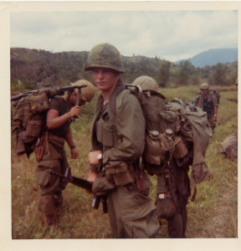 Now that we have our meal plans decided and food packed away for the next few days, our water needs are next. The summer months, March to October, was difficult for us in that we had to have enough water to last until the next resupply. On average, each man carried (4) quart canteens; I usually filled 1 or 2 with Kool-Aide or Tang orange juice, which were plentiful and shared among the troops when packages arrived from home. Those areas of operation that had rivers and streams were also good sources of water, but needed to be purified with iodine tablets first and then wait a couple of hours before drinking. These are the canteens that were usually converted to one of the special drinks as the taste of treated water was terrible; you also have to look past the color of the water as none of these streams and rivers were pure as melted snow on the Rockies – more of algae green or coffee brown. After purification, the sediment settled on the bottom, when shaking the canteen or drinking too fast caused spitting episodes after particles snuck through our gritted teeth. Note that four quarts of water weigh about 8 to 10 lbs.
Now that we have our meal plans decided and food packed away for the next few days, our water needs are next. The summer months, March to October, was difficult for us in that we had to have enough water to last until the next resupply. On average, each man carried (4) quart canteens; I usually filled 1 or 2 with Kool-Aide or Tang orange juice, which were plentiful and shared among the troops when packages arrived from home. Those areas of operation that had rivers and streams were also good sources of water, but needed to be purified with iodine tablets first and then wait a couple of hours before drinking. These are the canteens that were usually converted to one of the special drinks as the taste of treated water was terrible; you also have to look past the color of the water as none of these streams and rivers were pure as melted snow on the Rockies – more of algae green or coffee brown. After purification, the sediment settled on the bottom, when shaking the canteen or drinking too fast caused spitting episodes after particles snuck through our gritted teeth. Note that four quarts of water weigh about 8 to 10 lbs.
During the monsoon season, there was ample water no matter where you were in-country. Bomb craters were in abundance and usually filled with 10 to 15 feet of water; we’d designate one for bathing and another for drinking water, banana leaves and ponchos also helped collect rainwater during the storms, so we could get by with just 1 or 2 canteens and our canteen cup.
Bomb Crater at the beginning of Monsoon season
Bomb crater completely filled during the monsoon season
Food and water are now taken care of, let’s add the supplies needed to fight our little war. Poncho liners (quilted blankets of polyester and cotton) were usually stuffed into our rucks at that point to help keep the C-Ration cans secure and cushioned.
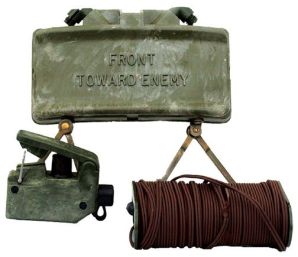 Then we packed (2) trip flares with wire and stakes, (1) Claymore mine, firing device and 50’ of wire with an attached blasting cap, and a 100-round link of M60 ammo (some draped the belt of ammo around the outside of the rucksack instead of carrying it inside). Certain individuals also carried rolls of detonation cord and blasting caps in their rucksacks which were used to daisy chain Claymore mines or wrap around a tree to knock it down for a Medivac to land. This was about all we could fit into the bulging ruck — the top of the rucksack had a drawstring that, when pulled, collapses the top to a smaller diameter. Before securing the straps of the ruck cover, we’d stick (2) signal flares on top and under the straps, so they stayed in place when closing up the pack.
Then we packed (2) trip flares with wire and stakes, (1) Claymore mine, firing device and 50’ of wire with an attached blasting cap, and a 100-round link of M60 ammo (some draped the belt of ammo around the outside of the rucksack instead of carrying it inside). Certain individuals also carried rolls of detonation cord and blasting caps in their rucksacks which were used to daisy chain Claymore mines or wrap around a tree to knock it down for a Medivac to land. This was about all we could fit into the bulging ruck — the top of the rucksack had a drawstring that, when pulled, collapses the top to a smaller diameter. Before securing the straps of the ruck cover, we’d stick (2) signal flares on top and under the straps, so they stayed in place when closing up the pack.
Remember, that each of us also had a set of suspenders attached to an ammo belt worn around our waists. This is where we stored extra ammo magazines for our M-16s, smoke grenades, baseball grenades, first-aid battle dressings, and our canteens. This ensemble was all we wore when going out on short patrols; leaving our rucks behind with a small crew to guard them or, in a day lager position where we’d spend two nights before moving on to a new destination.
C-Ration tin modified to use as a reusable stove to heat food water.
Heating a meal of spaghetti and meatballs
Each rucksack had three pockets on the side that we used to store a variety of things. Mine held several packs of cigarettes, packages of Kool-Aide, coffee, hot cocoa, sugars, powdered cream, salt/pepper, Tabasco sauce, Heinz-57 sauce, heat tabs, lighter fluid, snacks, and my cooking stove (a modified C-Ration biscuit can with holes in its side), foot powder and bug juice.
I’d roll my poncho into a small 12” long cylinder and tie it to the bottom of my ruck – just underneath the ammo can; I used it as a roof during the monsoon season and as my ground cover for sleeping at night.
The morning after the rains – drying out and eating breakfast
Still had to secure a machete and folding shovel to the ruck, and attach either a bayonet or Bowie knife to the ammo belt.
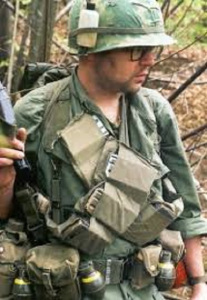 Finally, I’d add (2) cloth bandoleers of 5.56 ammo rounds crisscrossing them across my chest like Pancho Villa did his ammunition. Later in my tour, our Scout went to the local village and purchased hammocks for us as trees were plentiful. We usually balled these up and carried them in trouser pockets or stuffed them into one pouch on the rucksack.
Finally, I’d add (2) cloth bandoleers of 5.56 ammo rounds crisscrossing them across my chest like Pancho Villa did his ammunition. Later in my tour, our Scout went to the local village and purchased hammocks for us as trees were plentiful. We usually balled these up and carried them in trouser pockets or stuffed them into one pouch on the rucksack.
Steel pot on my head, ruck on my back, and M-16 in hand, we’re ready to go… total weight about 70 lbs which forced us all to walk bent over at the waist to support the heavy load. When stopping for a short break, we’d bend over almost 90 degrees to allow the pack to rest on our backs, thus giving our shoulders a well-deserved reprieve and allowing the circulation to return. Rucks were always bobbing and shifting while humping as soldiers tried to redistribute the weight so their arms and shoulders would not go numb from the lack of circulation. If we sat during a longer break, then getting back up after with a filled ruck was a comedy of errors. We learned to rely on our buddies and pull each other up or roll onto all fours and use a tree to pull ourselves up. There was no easy way to do it!
Besides those supplies above, each squad also carried (1) M72 LAW (anti-tank disposable missile) and several six-volt batteries, used for mechanical ambushes. We split this responsibility between the men and switched out daily.
The grunts below didn’t have to haul around Claymore mines, trip flares, machetes, and signal flares because of the primary weapons they carried:
Radio Telephone Operators (RTO) carried a PRC-25 radio under his rucksack, which added another 25 lbs, 2 spare batteries @ 5 lbs, and a long-range folding antenna. His total burden was still around 80 lbs.
M60 machine gunners added 26 lbs for the gun and 10 lbs of belted ammo. Usually carried a 45 cal. pistol on his belt with 3 additional magazines. However, most of us carried our “pig” by resting it on a shoulder and holding onto one of the fold-down legs – switching back and forth between shoulders when one ached.
Assistant gunners carried an additional 300 – 500 rounds of M60 ammo 35 lbs besides an M-16 and ammo bandoleers. Some of these guys also carried an extra barrel for the machine gun across the top of their rucksacks.
Thumpers or grenadiers carried an M79 grenade launcher – 10 lbs and wore a vest holding thirty mixed rounds (High explosive (HE), White Phosphorus (WP), beehive (shotgun shells), and CS gas–estimated at 25 lbs. He tucked away additional rounds inside of the rucksack.
Medics and corpsmen carried field bags filled with creams, ointments, pills, 2 IV bottles and syringes, sterile bandages, powders, foot powder, salt pills, and malaria pills for every person (1 white for daily and 1 orange for Mondays). I’ve seen some carry no weapon with them to the field (Conscientious Objectors) and others who carried pistols instead of M-16s.
***
The S-shaped country of Vietnam has a north-to-south distance of 1,650 kilometers and is about 50 kilometers wide at the narrowest point. With a coastline of 3,260 kilometers. Vietnam was divided into four zones during the war: I Corps: the northernmost area bordering Laos and the DMZ; II Corps: which included the Central Highlands, sandy beaches, and plateaus filled with rice paddies that bordered Laos and Cambodia; III Corps: comprised gently rolling hills and wide-open areas, large urban areas, rubber plantations, and thick jungles that border the well-stocked Cambodian sanctuaries. This area also included a lone mountain which was seen for miles in all directions (Nui Ba Den or Black Virgin Mountain); and IV Corps: a river delta laced with rivers and canals, often impassable for vehicles, soldiers used special shallow-draft gunboats, floating artillery and armored transports to seek and locate the enemy.
So now the fully equipped soldier was ready to go hunting. This is what he faced…
I Corps encompassed a narrow portion of the country (10,000 sq. miles) and favored the enemy. The western portion of the zone are rugged jungle-covered mountains that hid enemy supply bases and camps, east of the mountains, a narrow rolling piedmont quickly gave way to a flat, wet coastal plain much of which is covered by rice paddies and beyond which lie beaches of the South China Sea.
The western mountains were enemy strongholds for much of the war and Americans and their allies fought pitched battles against trained military forces from the north – The North Vietnamese Army (NVA) who could use artillery against the Americans from both Laos and North Vietnam. Major battles include Khe Sahn, Battle of Hue during the Tet Offensive, Hamburger Hill, and the Ashau Valley, among others. These mountains were treacherous and took days to climb – I remember having to tie myself to trees at night so I wouldn’t roll downhill. Climbing also took its toll on the soldiers ranging from heatstroke and exhaustion to sprains and back injuries from falls.
II Corps encompasses rugged mountains with dense forests that are broken by a rolling plateau from Pleiku to Ban Me Thuot. Tracked vehicle movement and helicopter landings here were severely limited. Poor weather and the great distance from supply centers were important limiting factors. Enemy forces in the highlands were mainly regular units of the North Vietnamese Army. Noted major battles included Dak To, An Khe, Happy Valley, Pleiku, and Firebase MaryAnn, to name a few.
III Corps included Saigon and a dense countryside that was riddled with many supply routes from the Ho Chi Minh trail and staging areas in Cambodia. It is also an area filled with hundreds of miles of tunnels, underground hospitals, and enemy staging areas.
In fact, the 25th Division’s main basecamp, Cu Chi, sat atop one of the most infamous tunnel complexes of the war – not discovered until after the war ended. Usually, Americans fought pitched battles against the VC and local militia fighters who blended in with farmers during the day or worked in the large cities, towns or even in the military basecamps. After the 1968 TET offensive, the battles almost decimated VC units within this area and NVA soldiers soon began filling in the ranks on many of the units operating here. Some major battles occurred in the Iron Triangle, Tay Ninh, An Loc, Michelin Rubber Plantation, Hobo Woods, and Nui Ba Den.
War Zone III was well suited for tracked vehicle movement which participated in many main force battles.
IV Corps: a maze of canals and rivers crisscrosses The Mekong Delta, covering about 40,000 square kilometers, a low-level plain not over three meters above sea level.
They ferried arms and supplies to entrenched VC soldiers via sampans and other small boats.
I know little about this area and welcome articles or commentary from those of you who lived and fought through this area. This includes Army and Navy brown water forces and PBR crews.
The heat, humidity, monsoonal rain, and groundwater meant that uniformed GIs in this area stayed wet most of the time.
Vietnam’s wildlife posed its own dangers. American soldiers encountered malarial mosquitoes, leeches, ticks, fire ants, and 30 different venomous snakes. One historian estimates between 150 and 300 US personnel died in Vietnam from the effects of snakebite.
A Banded Krait bit me. I was later told that I wouldn’t have survived the night had they not extracted me from the jungle and medivacked me to the 93rd Evac. Hospital In Long Binh.
Annual rainfall is substantial in all regions and torrential in some, ranging from 47.2 to 118.1 inches. Nearly 90% of the precipitation occurs during the summer. The average annual temperature is higher in the plains than in the mountains and plateaus. Temperatures range from a low of 41 °F in December and January, the coolest months, to over 98.6 °F in August, the hottest month. Humidity is always high and near 100%.
Jungle terrain is extremely difficult to hump through. Foliage grows so close together and thick that point men exhaust themselves by cutting a small corridor through the dense vegetation for those following. When cutting trails, we rotated the pointman every half hour between 3 or 4 men; it was also a time when that soldier was most vulnerable. His entire focus was on clearing a path and not looking for enemy soldiers. You already know that they are carrying a lot of weight and have to bulldoze their way through the bush.

Wait-a-minute vines with thick thorns latched onto rucksacks or around outstretched arms required the soldier to stop and have the guy behind him unsnag him so the column could continue. Exposed roots stuck out of the ground and caused soldiers to trip and sustain ankle or foot injuries. Sometimes, the hedgerows and bamboo thickets were so thick that only a small crawl space was available. Soldiers removed their rucks, and either pushed or pulled them through while crawling on their bellies. Now keep in mind that enemy soldiers are everywhere, booby traps are plentiful – even in the most obscure of areas, and insects are feasting on the sweaty, moving bounty. Oh, I forgot, some of this thick jungle terrain covers the mountains, so besides hacking a path, each soldier had to climb and then help pull up the man behind him.
Humping through rice paddies is an experience. They are filled with water and human waste to fertilize the rice stalks. Stepping through the thigh-high water in ankle-deep muck is extremely difficult. The muddy bottom sucks on the boots, making it very hard to pull them up and clear to move another step. This continues until they’re back on solid ground… I’ve heard of soldiers humping through paddies for entire days at a time. The main danger to soldiers is that they remain exposed during this time, with the only protection being the surrounding dikes, which might not be nearby if fired upon. VC snipers often harassed patrols from the nearby wood line which caused further hardship to the soldier who had to dive into the much for cover. It’s an extreme cardio workout!
Open flat areas and valleys usually have head-high elephant grass growing wild everywhere, which also conceals anyone moving about. This stuff is like the palm fronds we get at Easter. This grass is almost the same texture except for the edges, which are razor sharp and have small thorns. They’ll bend and move with the flow, but leave cuts on all exposed skin that is prone to serious infection.
Humping through the Delta area meant that soldiers trudged through water and swamps for most of their day. I know that World War II landing crafts transported patrols along the waterways to some solid ground to search for the enemy. It is also said that 40% of the country’s population lives in the Delta area. They build homes and villages on stilts and line the ever-present waterways.
In closing, I have to say that humping was a real challenge, no matter where in the country you are following the guy in front of you. No one area was more favorable than the other, and each offered these young soldiers opportunities to see nature at its best. In I Corps, we came upon huge caves and many waterfalls, old church ruins in the middle of nowhere, and the ancient city of Hue. In III Corps, we discovered tunnel complexes and underground hospitals that took our breath away, discovered beaches with pristine sand and emerald water (Vung Tau), and witnessed the oddity of the Black Virgin Mountain on the landscape.
Did it get easier over time? Some say it did, while others say no. I can attest that the first several weeks were the most difficult of my life in Vietnam. If you saw the movie Platoon, remember Charlie Sheen’s character who passed out on his first patrol? It was like that every day! We were all on a quest to reach our destination without passing out! If the word “Zombie” would have existed back then, it may have been used to describe us. If we ran into the enemy…well, that’s another story for another time.
Looking back, I’m amazed that we could do what we did. In fact, I can also say most honestly that I was in the best physical condition of my life during that year in Vietnam. No Regrets! I’d do it again if I were fifty years younger. What about you other grunts – did I nail it?
Thank you for taking the time to read this. Should you have a question or comment about this article, then scroll down to the comment section below to leave your response.
If you want to learn more about the Vietnam War and its Warriors, then subscribe to this blog and get notified by email or your feed reader every time a new story, picture, video and change occur on this website – the button is located at the top right of this page.
I’ve also created a poll to help identify my website audience – before leaving, can you please click HERE and choose the one item that best describes you. Thank you in advance!





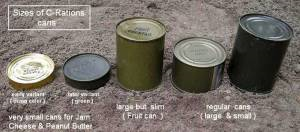

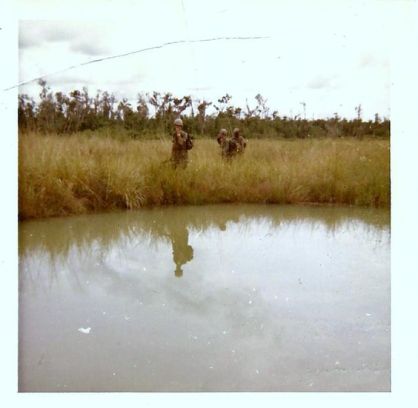



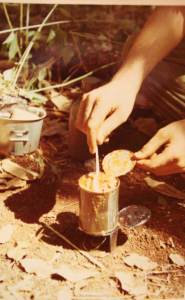
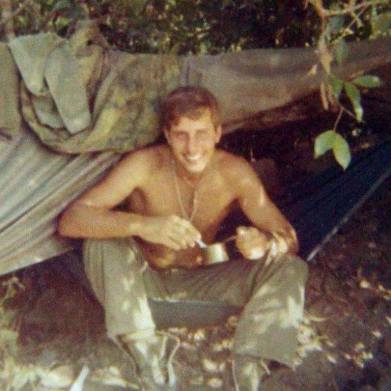

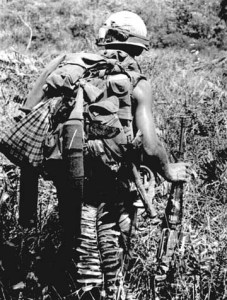
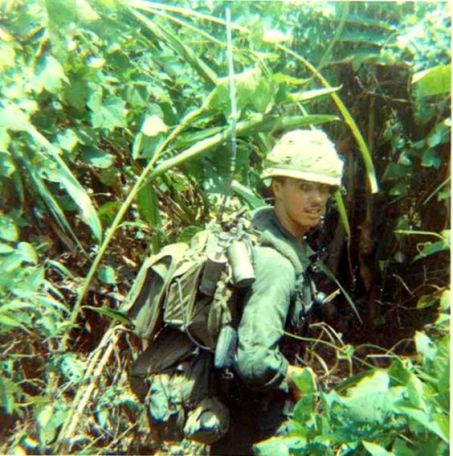
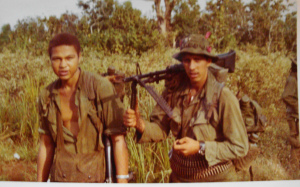






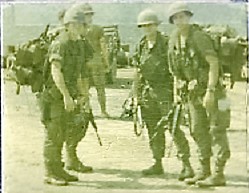
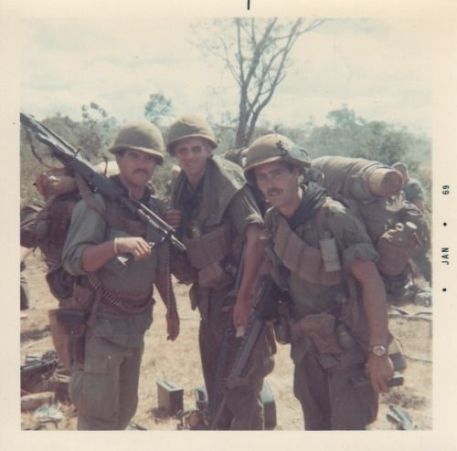

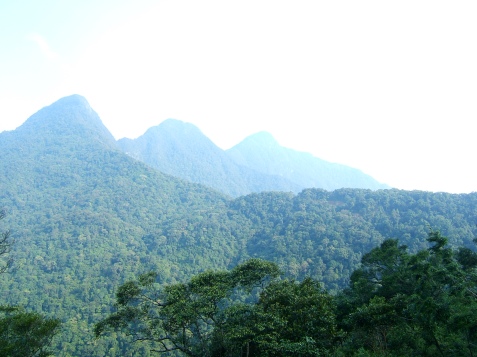
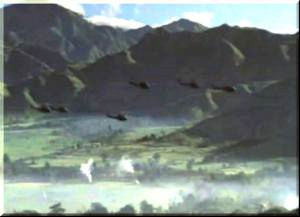

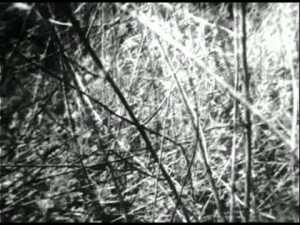


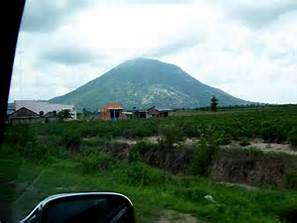
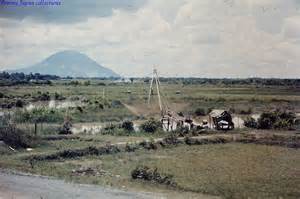
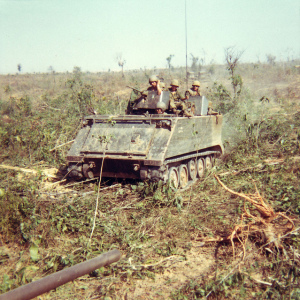
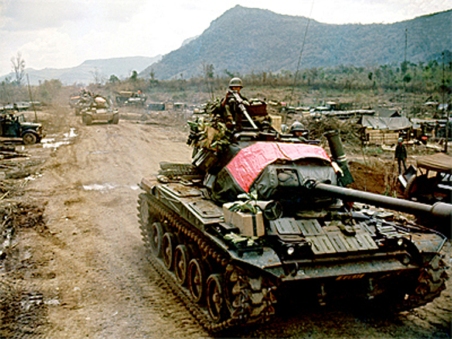




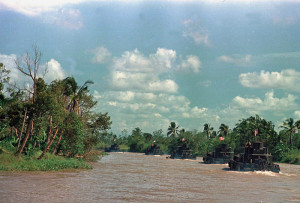
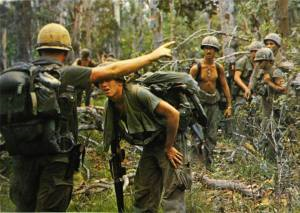
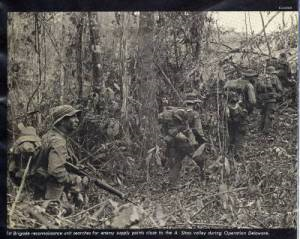
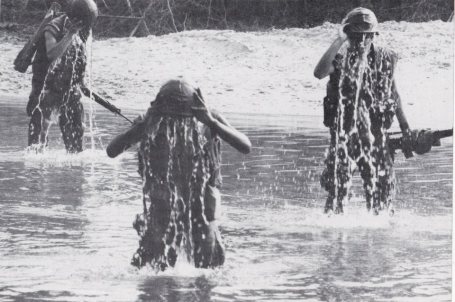

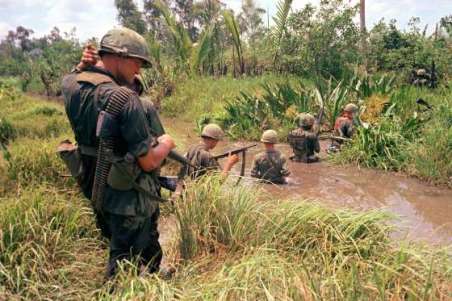
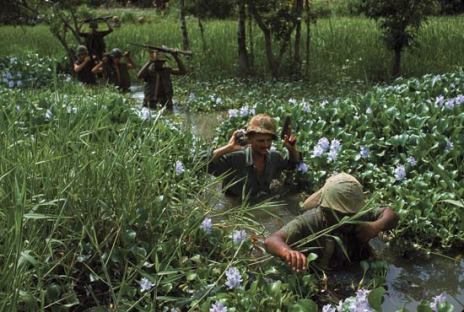

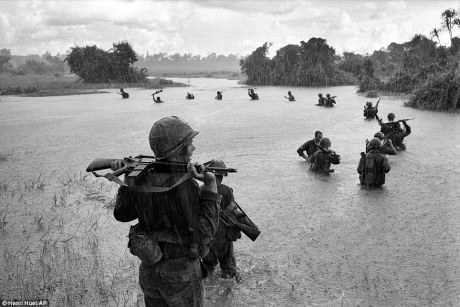
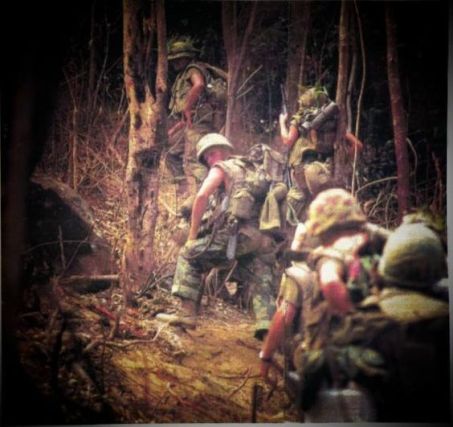
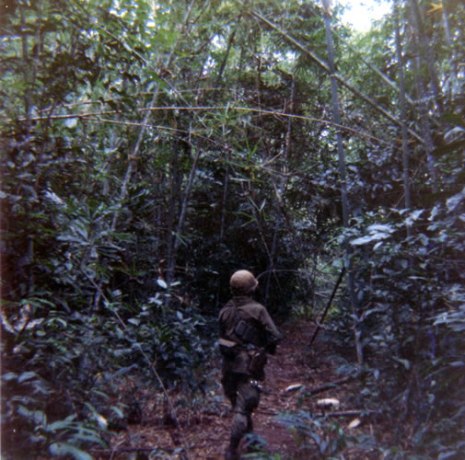


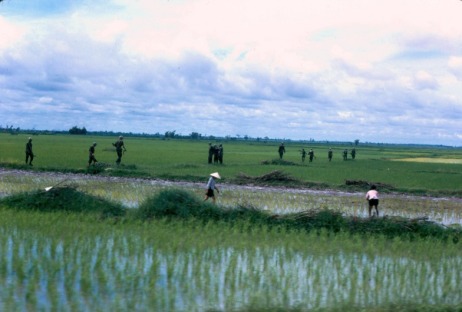
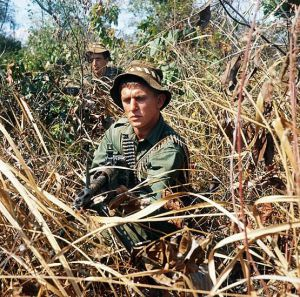





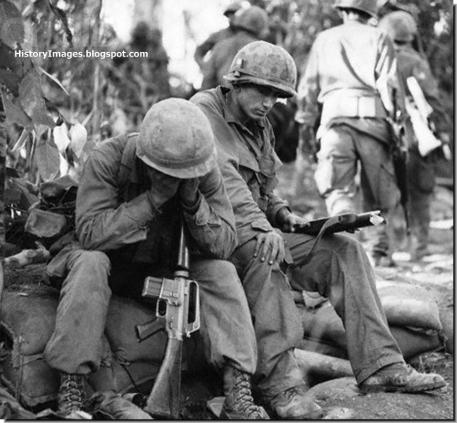

A well written article by a brother on a “day in the life” of Combat Infantrymen in the Vietnam War. Certainly there were minor differences depending on your unit and area of operations as to routines and habits. But the commonalities of men in War always outweigh any differences. Thank you brother, and welcome home! Sgt. C.M. Anthony..Charlie Co..1/26th..1st Inf. Div..Lai Khe, So. Vietnam..68-69.
LikeLike
About anti-malaria pills that I distributed as a medic.
Dapsone – One daily little white pill was designed to resist the Falciparum type malaria. And it was said to be 65% effective.
Chloroquine – One big orange pill weekly was designed to resist Vivax type malaria. Effectiveness unknown in Vietnam, however, I can remember Chloroquine still being used in the early 1990s.
LikeLiked by 1 person
Thank you for that information. I had an uncle who contracted malaria in the South Pacific in World War II; for the rest of his life he suffered intermittent long bouts of fevered delirium that would leave him soaked with sweat, weak, and disoriented. As a grunt in Vietnam, I took those pills you and your fellow medics distributed religiously. Thank you!! It was rumored that a few people stockpiled them and took a lot at one time to simulate malaria and get out of the field temporarily. I never saw that happen and can’t verify it. If true, I can’t understand why anyone would voluntarily inflict the symptoms of malaria on themselves.
LikeLiked by 1 person
Thought provoking
LikeLiked by 1 person
Hi John, thanks for this interesting and detailed post. I remember some of this information from your book. It is a wonderful thing you are doing, recording the detail of this time. It is very interesting and useful for people who don’t know.
LikeLiked by 1 person
The bloody environment in addition to the human enemy, what a toll. I hated Nam’s humidity. My salute to all who humped the boonies there.
LikeLiked by 1 person
Had two uncles that fought there both army. Sounded like my uncles telling me their stories, which by the way were far and few between.they didn’t talk much about the war.they would talk about the hardships and friends that were in their unit without ever really saying much at all about actual combat and they both saw quite a bit. I figured just leave it alone they had their reasons. My father had nine brothers and four sisters. My aunts were all military nurses in ww ll had four uncles in wwll… my father and two more uncles in Korea and two uncles in nam…my dad never spoke of the war he was army Sargent 82 airborne . I would ask him what it was like and he’d always say, nothing you need to know about this is not for you. I have great respect for all of them and for all vets active or not. Thank you for your story and for your service. And thank you to all who have served and are serving today. I mean that from the bottom of my heart and soul with great pride and admiration. Thank you.
LikeLiked by 1 person
Man this article was eye opening. I’ve always felt Vietnam was the hardest war fought. One question I do have. How long would you be on patrol before going back to a base camp.
LikeLiked by 1 person
It all depends. Most units visited a firebase after 6 – 8 weeks in the bush. Visiting a base camp as a company might be 1 – 2 times every six months.
LikeLike
Wow man that’s a huge difference to the fighting in Afghanistan guys would spend that much time at an outpost but I don’t think anyone spent that much time out on patrol other than maybe special units. Like I said Vietnam was a brutal war for us
LikeLiked by 1 person
up to 70 miles for LRP. 17th Inf.
LikeLike
I should have added that we were never issued flak jackets… thank heaven!
LikeLiked by 1 person
Excellent description of life as a grunt in the boonies. The only notable difference for me was that in the 5/7 1st Cav in ’70-71 we also carried ALL our water for the normal three-day humps between chopper resupplies. I carried something like 11 quarts but some guys carried more, up to 17 as I recall. Believe me, no one carried more water than he needed to survive, but no one carried less either. That added a LOT to the total weight we carried.
LikeLiked by 1 person
What about the flack jacket? We had to wear the damn things. D co 2/12 first cav 68
LikeLiked by 1 person
We only wore the flack jacket on ambush.
D/2/16, 1st Inf Div 1967-68
LikeLiked by 1 person
Were you FSB-based? In ’69-’70, we never wore them, as we were in the bush for 30-45 days, at a time. C-1/7, 1st Cav.
LikeLiked by 1 person
Don’t know if you are referring to me or anonymous but we (platoon) had enough to support a squad size ambush; other than that, no vest…not enough to go around and too damn hot. We were in the boonies 3-5 weeks at a time without hitting a base camp, sometimes working out of the same NDP, sometimes moving and digging a new one. One stretch we were out 85 days without a base camp stand down. Our main Base Camp was Di An with many different NDP’s, e.g., Normandy I and II, Redleg III, Siciliy VI and others can’t recall.
LikeLiked by 1 person
For whatever reason, in the 5/7 1st Cav we were not even issued flak jackets, let alone wear them.
LikeLiked by 1 person
Very good, but you also could have included those carrying 81mm mortars. We split them up among the sections: base plate, bipod, tube. Sight, aiming stakes, fire direction equipment, field phones, wire, etc. And many guys carried one mortar round of about 5 pounds on top of their ruck. Pretty miserable to hump.
LikeLiked by 1 person
You summed the experience up perfectly. I was with the 2/27 Wolfhounds and 3/17 Air Cav ‘70-‘71. Spent some time on top of Nui Ba Den that sure beat humping the jungle. I often thought dealing with the elements (bugs, weather, critters) on a daily basis was as bad as dealing with the occasional contact.
LikeLiked by 1 person
Just read this great article. Only thing to add is that we each had to carry a bulky mosquito net. Instead, we ditched them and had only one out of every three guys carry one b/c we slept 3 to a tent, in the bush. BTW, the picture right above your III Corp section is part of my 1st squad, C Co., 1 Btn, 7th Rgmt, 3rd Bgde, 1st Cav Div, in November 1969.
LikeLiked by 1 person
Great job. This is probably the most concise and clear description of being a grunt. I was in I Corp 18 months with initial in county training with Wolfhounds out of Cu Chi. We, newly arrived 101st toured Hobo Woods, Iron Triangle and Michelin Plantation.
Tet, ‘68 took us to DMZ, Hue and Ashau valley with plenty of wet and dry rice paddies.
The was also very different on either end of the country…. Winter months in I Corp were often miserably cold and wet.
Excellent article, and yes, I would do it again.
Thank you
36 D 1/502, 101st
LikeLiked by 1 person
To be useful in trying to describe anything about your experience in Vietnam I’ve learned you have to put it in context something like this: 1 When were you there? 2 Where in country were you? 3 What was your job? Why? Because “Vietnam” was a moving target, there were at least three major geographical areas, 1 delta, 2 lowland jungles/rice paddies, and 3 the highlands. In terms of time, from ’62—3 to 65 (OK, ’54 –‘65) was what some might call the “old war.” That was when the only US units there were MACV advisors, SF A teams, and helicopter units. The helicopter units bridged the gap between tactical and logistical assets in country. In ‘65 the buildup of conventional forces began. By ’70 the drawdown began. Then there was your mission, different folks carried different things due to different mission requirements. My experiences were significantly and probably necessarily different than those depicted in this piece. I was there in the ground in ’65 & ’66 this article was probably written for ’67 and later when the supply chain was more fully functional.
We didn’t carry the same (or as much) gear. You can’t stuff that much in a “fanny pack,” not even close. (Who remembers the fanny pack, or who wants to?) I couldn’t imagine carrying , or wanting to carry an ammo can for my “personal stuff.” Water, ammo, poncho, C Rats in a sock on your pistol belt, E tool, that was about it. There was a lot of non-issue arrangements. We didn’t have the jungle ruck as yet, so you had to improvise or go with the nearly useless fanny pack. Because many of us had trained in the jungles of Hawaii (way nastier than Vietnam jungles ever were) we had already worked out different gear carrying means. A few guys actually used the swag, not bad but a little slow in getting at any particular item. I, as well as others, went with a modified USMC Light Marching Pack or shoulder pack. By modified I mean, in my case, attaching (sewing) it to a set of Ridgeway suspenders. We didn’t have poncho liners; I remember carrying a sleeping bag cover wrapped in my poncho in a horseshoe roll around the pack for the cold nights in the highlands. (Yes, we learned that on Oahu, it can get cold as Hell on summit trail in the Kahuku’s!) Some guys used two crisscrossed GP straps as a harness, probably better than the Ridgeway harness. (A sewing awl was a key piece of equipment in those days.) All these non-issue items were readily available in Honolulu surplus stores. For the most part, most guys made do with the Fanny Pack and simply bitched a lot.
Even though it didn’t describe my particular situation, I found this rather extensive article interesting and memory jarring.
LikeLiked by 1 person
Thanks for your insight.
LikeLiked by 1 person
John, After reading your description of the life of a grunt, and then reading the comments it’s obvious that as a helicopter pilot in the Mekong Delta, I lead a charmed life. Your comments about the delta only cracks the surface of what it was like down there. It was always unbearably hot and you were never completely dry. There were no U.S. ground forces south of the river. Our CA’s were always inserting/recovering ARVNS. I will restrain my comments by only saying that it was a stretch of the definition of the word to call them “soldiers”. They were just as dangerous to us, maybe more so, than the VC and NVA because they had no reservations about shooting at U.S. helicopters. But that was nothing like what you grunts went through every day. I salute you brother. Thanks for your excellent narrative. Merry Christmas and welcome home.
LikeLiked by 1 person
After reading this it made me so sad because of
The suffering my brothers had to indure in the Vietnam war . Thank for letting us see real facts of what the soldiers had to do to stay alive. Thank you to all the men that served!
LikeLiked by 1 person
Well done. I was 2-6 (platoon leader) D Co. with the 1/5th Air Cav from Oct. ’69 to June ’70. It was the most difficult job imaginable, and I’ll admit that OCS hadn’t prepared me for the task. Fortunately, I had a fantastic platoon sergeant and great squad leaders who helped bring me up to speed. I humped heavy to include extra C4, flashlight, air mattress, three 3-quart canteens, six pack of soda, six pack of beer, maps, smokes to show choppers our position, for extraction or medevac and three grenades along with standard issue ammo, etc.
III Corps was relatively calm in ’69 and ’70, but things changed in May when we got the nod for the incursion into Cambodia. The countryside was beautiful with hills and open fields. There was also an abundance of bad guys claiming the territory as their own. The Cav had other ideas and went about destroying their infrastructure to include several large caches captured. The Cav was really annoying the NVA and their commanders evidently decided to retaliate by assaulting fire bases as retribution for our acts of aggression. FSB David was attacked by a reinforced company on 14 June 1970 at about 0300 hours. Our company was providing perimeter security as thick fog shrouded the area and limited visibility to a matter of just meters. At approximately 0300 hours a trip flare popped and a bunker guard thought he saw movement and fired a single shot without getting return fire. I went to the bunker to investigate but the fog prevented any real evidence of the enemy. I had called my CO (Bill Vowell) and suggested going full alert which we did. After about half an hour without further ado, everyone wanted to pack it in and call it a false alarm but right then a guy standing next to me thought he saw something and pointed to it right inside our wire when a burst of AK fire split the night air. The sapper attempted to drill me a new belly button but the bullets skimmed off the berm and grazed my head. Then all hell broke loose.
I got on the horn to our CO and gave him a sit-rep in my sector. Then I radioed the mortar crew and asked them to begin their preplanned fires into a steep ravine to our front and walk the rounds up the slope in front of our position when a Chi-com grenade rolled up next to me and detonated .severely wounding me and taking me out of the fight. The battle raged until sunrise when the enemy retreated leaving 28 of their elite sappers behind with numerous blood and drag trails as evidence of additional casualties.
I tell this story because FSB David was anything but a routine battle. What made it special? David was beyond artillery support from all other bases, and the fog prevented aircraft assistance. Thus, the defenders repulsed the enemy without support. The fighting was face-to-face at times and several bunkers had been taken over in the process. The Recon CO (Mike Crutcher) led a small force and promptly took them back into friendly hands. Now here is the kicker; Not a single GI was killed during the battle, We sustained 34 wounded and I nearly bought it, but somehow made it thanks to some very professional medical personnel.
As I mentioned before, the fighting was fierce and there were numerous acts of heroism. To be specific, 11 Silver Stars were eventually awarded to the brave young men on David.
I spent a year at Walter Reed recuperating from my various wounds which included a punctured lung, three pieces of shrapnel in my heart. a blind eye, pulverized elbow and too many holes by shrapnel to count. The Army decided they didn’t require my services any longer and gave me a 100% disability meal ticket. I returned to civilian life and have led a near-normal life. I am now fully retired after a career in sales and marketing. Life is good.
LikeLiked by 1 person
Thank you, Joel, I do appreciate your comments and glad you made it home. / John
On Mon, Nov 25, 2019 at 5:07 PM CherriesWriter – Vietnam War website wrote:
>
LikeLike
For those that weren’t lucky enough to have this experience, one day of it will set you straight. Remember no complaining allowed. 😂
1st/502nd/101st Abn 1970
LikeLiked by 1 person
I have been looking for material like this – about daily life in the bush for grunts. I was a draftee in a rifle company of the 1st/35th 4th Inf Div in the Central Highlands in 1969. Only made it through 5 months thanks to a run in with a booby trap while walking point.
I particularly remember the “wait a minute” vines – horrible stuff. Especially if you were first man through. I always carried a machete – stuffed down the top of my pack when not used – absolute necessity.
I remember what a treat it was to pull perimeter guard for a forward firebase. Big bunkers, hot food, maybe even some beer (which we would bury in 105 shell casings over night and drink first thing in the morning when it was cool). One time the cook came out to the perimeter and handed out fresh donuts! After humping for 2-3 straight weeks it was heaven.
LikeLiked by 1 person
Well written, I was a REMF, HHC, 4th Trans Command Saigon Port July 66 to July 67. We had facilities at Saigon, Cat Lai 11 miles down river from Saigon where all the ammunition ships were unloaded. The ammo was placed on barges and brought up river to Cogido where they were unloaded and the ammo was trucked to the Long Bihn Ammo Dump, New Port 6 miles up river from Saigon, Vung Tau on the South China Sea and Can Tho, My Tho, Dong Tam and Vhin Long in the Mekong Delta, plus 11 barge discharge sites up and down the Saigon River. I got to visit all of those places a time or two. My heart goes out to those who had to hump the bush day after day. As for the comment from Yunis, above, you can make an aerial pass at a rolling donut for all I care. You don’t have the balls to do what these brave men did. If they put a pack on your back and a rifle in your hands, you would have the Hershey Squirts before you got out the gate.
LikeLiked by 1 person
I had the opportunity to visit a few of these places. It was utterly shocki g and heartbreaki g to see the damage done by the americans. Especially agent orange and its annihilation of man and nature alike even 40 years later. And after all you went through that war was a total defeat and embarrassment to america. Do i hate people .no i do not but the actions of americans in a foreign country tapei g killing torching spilling their lust for greed and power….
LikeLike
So many memories. I was with 3rd herd, Mike 3/1 USMC on Hwy 9, KheSahn.
I was only in country 75 days (March 17 – June 1, ’68. Medevacd with all my grunts
after 4 hearts. Mike took 100% casualties and the Corps retired us. I lost 14 of my
grunts, don’t have a clue how many 1st and 2nd platoon lost. My sons constructed
a beautiful granite memorial with all 14 names on brass plaques and flag pole in our front yard. The neighbors stop by frequently during their morning walks.
Thanks for writing this article. And a special thanks to all our Army, Navy, Air Force and
Merchant Marine brothers and sisters for their service, then and now. Love all of you.
Semper Fi.
Doc Pueschel
LikeLiked by 1 person
Excellent.
LikeLiked by 1 person
Well done . Different troops packed their gear differently . I had M14 ammo pouches that held 4 Mags , and 2 grenades on the outside . I never carried my 300 rounds ( 2 boxes ) of M60 ammo unpacked . Less chance of getting the ammo dirty . I carried 3 canteens , and a 2 qt. bladder that I picked up somewhere . Carried c-rats in my spare socks . Flack vest was a double edged sword . It was hot , and heavy , but kept the straps of the web gear from cutting into my shoulders .4 grenades . 2-smokes . 2- flares . 1- LAW . 1 pound of c-4 , to cook with . Sundry personal items . 1-claymore . 1-bayonet . 1- entrenching tool . Hell . I couldn’t even pick up that pack today .
LikeLiked by 1 person
I wouldn’t be able to pick mine up either!
LikeLiked by 1 person
I too was an infanfryman with 2/506 (101 airborne) in 1969/70. All what You wrote and pictures I kind of relived them when I saw them!! Keep up the great work.
LikeLiked by 1 person
Very interesting, similar feelings are evoked patrolling in Afghanistan during both the wet and dry season.
Best regards to all grunts. Past, present and future.
LikeLiked by 1 person
There wasn’t a more difficult assignment in the Nam as a combat infantry man! ambushes, lp’s, after humping all day and digging your night fighting hole
LikeLiked by 1 person
great article — reading this has taken me back 50 years, to when I was a young lad, walking point with my platoon in the Central Highlands, 101 st Airborne
3/506th infantry — thanks for a great website, and thanks to all our brothers
who served — Happy Thanksgiving — keep America great
LikeLiked by 1 person
GREAT I remember very well
LikeLiked by 1 person
Very well done. Brought back alot of memories.
LikeLiked by 2 people
Love the first hand account. Thanks is simply not enough for this generation of selfless soldiers (men & women), thank you for your service to a cause to lay down your life for another human being while in a foreign land. Soldiers defend the decisions of politicians and many gave their life to defend the ideals of freedom. May God bless America’s finest, a “soldier!”
LikeLiked by 2 people
Wow! Brings tears to my eyes,…..1969-70 was a proud member of the famed Bushwackers of the 720th MP Co B , 3rd Platoon,3rd squad. MP’s were not supposed to have that kind of duty,…. But we did. Reading this story brought back all those memories……….How did we survived!?!?!? Thank God we were young! I had forgotten all that we carried EVERY day, ………I went down to 130 lbs. My respect and love of my fellow MP brothers is what I hold dear to me of those two years of hell.
LikeLiked by 1 person
Thanks for creating this. It certainly brought back memories of my Vietnam Nam experiences. I was with the 4th Infantry Division in and around Pleiku. We humped from mountain top to mountain top each day carrying everything you described. I looked forward each day to enjoying a hot can of 3.2 beer. We’d get a six pack and somehow fit it in our rucks. I remember nothing about having a place back in base camp to keep my belongings. I flew into Bien Hoa from New Jersey. After a few days of working details we were flown up to Pleiku. I guess that’s where my duffel bag, personal items, and I parted ways. After we were issued our weapons etc. we were trucked to Camp Enari, a forward base camp. For the next three months we lived in the boonies. No showers, few hot meals. We did receive mail and packages. The boxes from home we’re shared, the food eaten that day. My grunting days ended after 93 days in country. I was wounded, medivaced to An Khe, and the rest is history.
LikeLiked by 1 person
A VERY JOB WELL DONE BROTHER! My tour was June 1968 to June 1969. I was assigned to 3/12 Co. C, 4th Inf . Div. as 11B20 did my tour in the Central Highlands, as a pointman for 30 days mandatory, then volunteered for another 7 mos. as a pointman, also carried the M-60 my “Baby” the entire 12 mos tour served under Great Men! and Grunt brothers lost some, who gave ALL! “Tears” I still keep in touch with Sargent Aaron Collins from Maine Platoon Sgt.
and Ashley Harrington from Georgia, Special thanks to all that contributed to our assistance one way or another, we were ONE UNIT contributing to the same cause, “Freedom” I thank God for our safe return home to our loved ones. WELLCOME HOME BROTHERS!! and may GOD KEEP BLESSING AND PROTECT AMERICA!!!
LikeLiked by 1 person
As one of those Grunts from 1969-70 I Corp, I’d say you captured that experience as well as anyone could. Well done!
(Reading that, I could feel those straps on my shoulders again. Where’s my towel!)
LikeLiked by 1 person
It ….very good !!
LikeLiked by 1 person
Good !!
LikeLiked by 1 person
Well done! I laid awake often after coming home trying to remember what I carried. And you hit my weight spot on. 135 pounds when I left. The only thing I did not see and may have skimmed over were the accursed leeches everyday! 199th Infantry B 3/7
LikeLiked by 2 people
I could not have said it any better. Family and friends never believe me when I share my memories and show them pictures. Did my time from Hill 937 to FB Ripcord as an artillery surveyor for the Balls of the Eagle.
LikeLiked by 1 person
Thank you for your service and sacrifice, brother!
On Thu, Feb 15, 2018 at 2:06 PM, Cherries – A Vietnam War Novel wrote:
>
LikeLike
I was with Lima co.3/1 usmc 0311, grunt! spent my time in I core oct 67to dec 68 ! I forgot about all the shit we had to hump! Thanks! Well done! Semper Fi!!
LikeLiked by 1 person
Wow what a great article, I was drafted serve with the 3/12th 4th Infantry in the Central Highlands 1970 and was transferred to the 3/506th hundred first Airborne Division Camp Evans I was a “GRUNT”it’s hard to describe to people what my life was like back then.thanx
LikeLiked by 2 people
Very insightful, thank you for sharing, my grandad fought in the 2nd world war but never really talked about it. Personal accounts need documenting for the future. Thanks again sir.
LikeLiked by 1 person
My friend you have nailed it. I couldn’t agree more of your description of humping the boonies. Viet Nam was a war of living conditions. 8 out of 10 people supported the booie dogs.
LikeLiked by 1 person
My Grandfather (Army in World War II) and Father (Vietnam era but code breaking in the Navy so not with ground forces) served so I spend time researching both of those wars to better understand what our service men experienced during that time. This article was amazing!
It provided such specific information regarding day-to-day life. I also enjoyed reading all of the comments left by others.
As a pediatric speech-language pathologist, Mom of two daughters, and US citizen living a cozy life in the suburbs, I cannot begin to understand the difficulty of what all of you did during that time………..but please know that I am forever grateful and in awe your bravery, strength, and perseverance.
Also know that I pray for you and am thankful that you made it home!
LikeLiked by 1 person
I humped, in the central highlands.I also was in the mortar platoon and had to carry part of the mortar,liked to carry the baseplate could strap it to the rucksack with all the other stuff. I was with c1/35 and a2/8 4th inf 69/70
LikeLike
I was a skinny tanker….all of 140 lbs when I got to Nam in 67….now and then we would perimeter with grunt units..don’t know how those guys did it…I do remember a few times that grunts told us that they felt a little more secure when we were around,,,,also I had a secondary weapon ..a little carbine…one night a grunt told me don’t use that…they knew the sound and he said VC used them …so ditched that carbine….and instead had a .45 grease gun and a .45………………………………..utter respect to grunts
LikeLiked by 1 person
I lost 30 lbs (175 to 145). Co. E/3-7th Inf, 199 Light Infantry Brigade.
LikeLiked by 2 people
Thanks for the memories, D-5/12, 199th LIB, 1968/69.
LikeLiked by 1 person
Just reading and bouncing around. I so regret sometimes that I took pics of a thousand things but never one of my full ruck. Was an FO RTO so had all the usual junk plus the PRC25 and two bricks that posed as batteries.
LikeLiked by 1 person
Left out very little but We were Black and really didn’t count
LikeLiked by 2 people
C. Company 326th Combat Engineers, 101st ABN DIV , 67,68
LikeLiked by 1 person
fogot to add, with the 3/187 , 101st Airborne
LikeLiked by 1 person
Great artical, don`t know how we did it.
LikeLiked by 1 person
Great !!!
LikeLiked by 1 person
Straight legs had it rough. I was a mech warrior and my load was much lighter. We usually spent one month in FSB, then two months in the field. While there were advantages to riding APCs, during rainy seasons they were basically taxis. They would drop us off and we would hump for 5-6 Klicks. While we were resupplied daily with one hot meal in the veg, and soda and a large block of ice, if Chucks didn’t know where we were because of the noise the tracks made, they had visual certainty of our night laager positions when the Chithooks dropped their load off at dinner time. Don’t be pissed at my good fortune as a riding grunt, my days were 24 hours long too, and I almost never got to stay inside the wire at night.
LikeLiked by 1 person
I was 11B40 (later 11F40) with 2/28 1st Inf Div out of Lai Khe. Pretty accurate.
LikeLiked by 1 person
I was with 2/28 first division out of Lai Kai, the black lions. I was with them from 69 early 69 and early 70. About 60 miles Northwest then called Saigon. I believe Tai Nhn province.
LikeLiked by 1 person
I guess time tends to dim some memories, especially the worst if them. Pictures though will bring them back in a hurry. I worked everywhere except IV corp, lucky enough to stay out of the Delta. Thinking about the loaded ruck when in a platoon, the reduced pack when in small teams, both had their miseries. Learned over time what was necessary vs convenience. The heat, the tanned rain, mosquitoes, leeches, thorns, elephant grass, and the dreaded crossing of an open paddie, not sure why or how I made it back. I try not to think too much, but the stories at the VFW seem to get funnier as time goes by, no reason to rehash the reality and sorrow associated with the truth. Thanks for posting this.
LikeLiked by 1 person
Excellent, just absolutely excellent. Our platoon leader favorite saying was, “home is where you dig it”.
LikeLiked by 1 person
Excellent well written. I for one did not carry C’s used the space for extra ammo. I would go to the PX and get beefjerky hot sausage afew small cans of beenie weenie and crackers and afew candy bars. Much lighter than C’s. I would eat c rations only when resupplied in the field. I would try to carry as much ammo as possible. Afew times if we saw a snake we would kill it and eat that. Inside my poncho i would put in a pair of jungle fatigues.side pockets on my trouser a few underware and scocks. A/co 173rd 1/503rd inf.
LikeLiked by 1 person
I also was 11C 40. 3/7/199 Feb 1968 thru Feb 1969. RTO/FDC/ FO. Begin back a lot of memories.
LikeLiked by 1 person
Good read. I was with B 1/8th Infantry, 4th Infantry from April 68 to April 69 in the Central Highlands. Did not know from day to day where my head would lay for sleep.
LikeLiked by 1 person
Very accurate. I was in 5/12 199th INF BDE 1968-69 in Iron Triangle area. Patrolled and ambushed in rice paddies, rubber tree plantations, and pineapple plantations, along with thick single-canopy. Night patrols were the worst. Could not see jack, hacking in darkness with a machete, hot as an oven, stinging insects and 6-inch long leeches attached to us for hours until we could get out of water long enough to pull them off each other (mosquito repellent and a cigarette would get rid of them). Learned we didn’t need much to eat and all came home thin. Every single day I still think about some of the ungodly things we experienced.
LikeLiked by 1 person
i was in a mech unit 4th id 2nd 8th, spent one year outside the wire and about 25% was on the apc rest of the time was humping the mtns west of dak to , kontum, pleiku and the only time i slept on a cot was when i was dusted off for maiaria and r & r in hong kong,. i consider myself a grunt with a 60 lb rucksack and 14 lb m60 climbing mtns.
LikeLiked by 2 people
Excellent and quite accurate.
I carried my M-60 with an additional 300 rounds around my waist. 😧😰
LikeLiked by 1 person
Just amazing! Y’all have my utmost respect! Welcome, God Bless you all!
LikeLiked by 1 person
Very good, well written and right on. I humped the Central Highlands in 67 & 68 with the 173rd Airborne. I carried the M-60 for 8 months, never carried it on my shoulder. I had a sling on it, slung over my shoulder so I was always ready to “Open Up”.
LikeLiked by 1 person
Thanks for bringing up all the bad memories of my life in the hell of Viet Nam, 2/12 cav, 11 bullet stopper was I and carried all the articles mentioned plus a 81mm mortar bipod.I came home a real skinny shit and was called the little Sergeant by soldiers at Fort Jackson where I was stationed upon my return from across the pond. Good job on your article.
LikeLiked by 1 person
Glad I was just a “dumb assed tanker”. I was with the 3/4 Cav, 25th ID from NOv 67 to Aug 24, 68. used to hook up with the Wolfhounds and we knew we were always going into the chit!
Had a couple of wolfhounds save me on Aug 24, 68 when we were near the Ben Cui Rubber plantation next door to the Michelin rubber. We got the snot pounded out of us that night.
After that, Alpha Troop of the 3/4 existed only on paper for a couple of months I was told.
I was medevaced out of there. It was one he11 of a 9 months for me.
I did my share of LP’s, and AP’s like anyone else. Never got a CIB even though I got a Purple Heart on the ground. Got 3 PH’s.
I don’t believe I’d have made it as the “straight leg grunt”. You guys were awesome.
The Wolfhounds were ALWAYS awesome!
Welcome home to all you guys. You are the BEST in the world.
Bob
LikeLiked by 1 person
Thank you for your commentary, Bob! I do appreciate it. Thank you for your service and Welcome HOme, Bro!
\
LikeLike
Excellent article should be required reading for high school, college history classes. Very accurate. This from a former Marine 0311 grunt, ’68-’69 ICorps G2/4 3rd Mar. Div.
LikeLiked by 1 person
Thank you, Bob! I appreciate your comments. Welcome Home and Semper Fi!
On Thu, Jul 14, 2016 at 9:49 PM, Cherries – A Vietnam War Novel wrote:
>
LikeLike
I’m Canadian and I stand to salute you great job my friend welcome home
LikeLike
You covered it very well. As a Army grunt with Bravo Co. 3/22nd Inf. 25th Inf Div 69-70 around Tay Ninh , Nui Ba Den and Cambodia 30 day incursion we did all that you wrote but I never carried an ammo box…………….just my topo map, machete, and compass as I was a point man………….
LikeLiked by 1 person
Thank you, Dana! Welcome Home Brother!
On Thu, Jul 14, 2016 at 7:49 PM, Cherries – A Vietnam War Novel wrote:
>
LikeLike
Excellently written and factually based. I was 11B with D/2/16, 1st Inf Div, 7/67-6/68. I was the PL’s RTO for half my tour, then weapons squad leader for the duration. I carried the M-79 even as an RTO because my PL wanted me as a supplement to his M-16. As a squad leader, I continued with the M-79 because it never jammed or misfired. A small correction: unless the 40mm vest was revised, it had 6 pockets, two in the lower level back, and two each upper and lower front. Each pocket held three rounds for a total of 18 for the vest. As an RTO, I only carried 15 rounds with something else, I can’t remember, in the 6th front top pocket….maybe hand grenades. As squad leader I carried those 15 plus 24 more rounds in a claymore bag and one in the weapon. 40 rounds of HE, at 10 ounces each, totaled 25 pounds, although I did have a few buckshot rounds. I never even saw a gas or WP round.
I passed the article on to over 350 VVA/VFW members. I could feel some of the pain, exhaustion and misery brought back while reading. At 5’11”, I weighed in at 143 lbs. in thin but fabulous shape.
Thanks again for something a non-grunt can’t even imagine.
LikeLiked by 1 person
Thank you, Don! Thank you for your service and Welcome Home!
LikeLike
Thank you, Don! Welcome Home Brother!
On Thu, Jul 14, 2016 at 4:47 PM, Cherries – A Vietnam War Novel wrote:
>
LikeLike
Fantastic, my friend, fantastic coverage
LikeLiked by 1 person
Thank you!
On Thu, Jul 14, 2016 at 3:22 PM, Cherries – A Vietnam War Novel wrote:
>
LikeLike
I was not there.Served prior in 57-59.It was an informative piece from a grunts view and that’s all I care about or value!!
LikeLiked by 1 person
I salute all of you. Uncle kept me watching the back door – Germany. I was one of the lucky ones. You guys have my highest respect. 13 Bravo.
LikeLiked by 1 person
A very good article.
LikeLiked by 1 person
I was in country 70-71 on MACV Team 73 Kien Thien District Choung Thien Province half way between Choung Thien Province and Bac Lou in four Corps. Kien Thien District is where the first two VC BN’s were formed to fight the French. Of course they became VC. There were as many when I left as when I got there though we had a body count of over 1,700 in our district alone. Your article is Very good but of course it does not cover some terraine like sliding on your stomach on soft mud and elephant grass islands in the Mekong River. Luckily I was to far south for that. As an Operational Intelligence NCO I carried a PRC-25 radio and all of my other gear. There was only two of us (the senior Advisor and my self..that went on combat missions with the District Chief. We were a five man District Team. I know that there were so many different stories that will never be told. I am sure that I have mine and I appreciate hearing those of others. It helps everyone to talk about those experiences.
LikeLiked by 1 person
Thank you MSGT! You are correct that there are 3 1/2 million different stories and most will never be told. The purpose of this website is to keep the spirit of the Vietnam Warrior alive through articles and feedback from readers like yourself. God Bless you and Welcome Home!
On Thu, Jul 14, 2016 at 11:12 AM, Cherries – A Vietnam War Novel wrote:
>
LikeLike
All of what you said is so true. It varied a little from guy to guy. Myself, I carried about 6 quarts of water. I carried LRP rations, not canned, A machete, m60 can for personal stuff. Poncho, couple of frags, couple of smokes, one claymore, few lbs of C4, 3 bandalers of M16 ammo. One jacket on my helmet and a 30 rnd jacket in my M16, all tracers. I didn’t carry a trench digger (shovel). of course on me, I carried a leg knife and my bowie on my hip. Yep, carried about half my weight, maybe more. A day for me was a click, up one hill, down another. If it was relatively flat, we covered more. I was a point man. awww, the good ol days…………….
LikeLiked by 1 person
Thank you, Paul! I do appreciate your response…Welcome Home, Brother!
On Wed, Jul 13, 2016 at 11:13 PM, Cherries – A Vietnam War Novel wrote:
>
LikeLike
Very accurate. I was the F.O for an infantry company in the 25th infantry division. This article brought back a lot of memory. Most of them not good!!
LikeLiked by 1 person
Having served with A/2/502, 1st Bde, 101st Abn, Sep 66 – Sep 67, we were known as the nomads of Vietnam, never staying in one place more than a month and always in the field, 25/30 days of the month. Arriving at Phan Rang, our base camp, I moved to Tuy Hoa and then north from their, returning to Phan Rang once to stand down for 14 days and finally for my DROS back home. Your comments about the Central Highlands, Dak To and Kontum in particular, were right on. Your article is extremely well documented and brought back memories of some of the finest men and soldiers ever to have served our great nation. Thank you for your service and welcome home, brother.
LikeLiked by 1 person
Back at ya, my brother! Welcome Home!
On Wed, Jul 13, 2016 at 8:15 PM, Cherries – A Vietnam War Novel wrote:
>
LikeLike
Hello brother 😄
LikeLike
Jack Hermann, Sgt. 3rd Battalion, 7th infantry, LIB, iron triangle northern macong delta 1966/67. You were spot on about humping the boonies. Alice packs, 5 days sea ration supplies, machine gammo, claymore mines, long range patrols, night ambush.
LikeLiked by 1 person
Thank you, Jack! Welcome Home Brother!
On Wed, Jul 13, 2016 at 7:55 PM, Cherries – A Vietnam War Novel wrote:
>
LikeLike
YOU NAIL IT BROTHER I WAS IN CLASS OF 68GARRY OWEN 2/7CAV Dd
LikeLiked by 1 person
Thank you, Dan! Garry Owen and Welcome Home, bro!
LikeLike
My name is Carl Davis and I served as an 11B2p (Airborne Infantry) with B/4/503rd Inf. 173rd Airborne Brigade (Sep) The humping was hard in the Central Highlands jungles to the point at times you were hoping to make contact just so you could kick that heavy, ass-kicking ruck sack to the proverbial curb! When I was with “The Herd” we had to keep the machine gun ammo in their cans strapped to the bottom of our ruck sacks. Lord have mercy how we got through all that I’ll never know. Was it all just a dream or did that shit actually happen?
LikeLiked by 1 person
I know what you mean about the firefights giving a reprieve to the aching muscles. Thanks for the comment, Carl. Welcome Home Bro!
LikeLike
Very enlightening for me, thanks for writing it. I spent my time flying UH-1’s out of Tay Ninh with the 1st Air Cav in ’69-’70 & counting my blessings that I got at least one hot meal every day and that I had a bunk to sleep in most every night…i did not envy you guys that I hauled around and dumped off into the bush. On the other hand, I know what it is like to hover a few feet above the ground in a hot LZ watching muzzle flashes and tracers zoom by while waiting for the flight to unload and to depart. I used to ask non veterans how long they thought it took to unload a helicopter of 8 grunts or 11 ARVNS while under fire and usually got unsatisfactory answers, and then one day I had an LT tunnel rat from CuChi say, hell man we were out in seconds! And that was a great response from his perspective….on the other hand, my perspective was that it took an eternity! We flew in all kinds of weather and conditions, day and night and we felt blessed that we could support y’all with what ever you needed: meals, mail, ammo, flares at night, medivac or USO shows. When it got to be my turn to fly some USO VIP’s around III Corps, there were no round eyed girls in the bunch just 8 Chicago Bears in camo! I said ‘no offense guys but you were not what I was hoping for!’ Oh well, there was a war going on. I had two great days that I remember distinctly, thanksgiving day and Christmas Day 1969. I spent both of those days flying hot turkey dinners to the boonies and usually into a very small LZ’s where we had to hover down from the tops of the trees, you guys showed your appreciation as it was written all over your faces, those were two very satisfying days in a crummy situation. On the 21st of April 1970, I was shot and shot down by a .51 cal close to the Cambodian boarder and by the grace of God, I survived to tell the tale. A few weeks later my unit was part of the Cambodian invasion that was long over due. And today while I still try to suppress all those memories, there is not a day that goes by that I don’t think about Vietnam and the brave brothers who I served with. God bless you guys who answered the call to duty.
LikeLiked by 2 people
Thank you, sir! Chopper crews have always been held in the highest regard by grunts for the reasons you mention. You did fail to mention that even though you slept in your own rack during the night, it might only be for 2 hrs. because you were “on the job” for 20 hrs. straight the day before. God Bless you all for being there when us grunts needed you!
On Wed, Jul 13, 2016 at 9:01 PM, Cherries – A Vietnam War Novel wrote:
>
LikeLike
I was assigned to A company 3rd Bn 503rd Abn Infantry 173rd Abn Bde. Our SOP said every SKYSOLDIER would carry 21 magazines with 18 rounds per magazine. The first two and the last two were tracers. Every one carried 100 rounds of m 60 ammo. M60 ammo and 3 bandoleers of M16 were placed on top of the rucksack for easy access, when we made contact. I used canteen pouches to carry my magazines and 4 grenades on my LBE. I also carried two smoke grenades one red, and the other yellow, or green. My M60 gunner carried the gun and 6 to 8 hundred rounds of 60 ammo, his assistant carried the same plus the basic load for his M16. The M79 gunner Carried 45 to 50 assorted rounds. Every soldier except 60 gunner 79 gunner medic carried a claymore mine. The Platoon leader and.squad leaders carried the C4 and blasting caps. When we were pulling security on the fire support base, the Co would have mad minute at stand to. In that minute we would fire as much.ammo as we could. The 60 ammo was dirty and some of the rounds were not linked properly. This caused the gun to jam. The food and water and other items carried were the same.
LikeLiked by 1 person
Thank you, SSG Bill, for your feedback regarding ammo and other supplies. It is much appreciated! / John
On Fri, Sep 9, 2016 at 1:17 AM, Cherries – A Vietnam War Novel wrote:
>
LikeLike
I was demo man with B/4/503 march 68
LikeLiked by 1 person
Sky Soldiers Mr Davis! Thank you and welcome home. We still have Operational Maps and pictures from your time in Vietnam in our Battalion CP hall in Italy.
B/2/503rd Inf. 173rd (2014-2018)
LikeLike
I was with B/4/503rd from early 68 to mid 69 then went to a/2/503rd I was recon sgt for FO team nick name babysan. We did things a bit different especially the bandoliers, if you left the mags hanging out side the top catch they would fall out while humping if we kept them in and cut one side they were still a bitch to get out while on your stomach caused me a lot of grieve and life. devils fingers in Dak To got Joe got bayoneted and I had to bust the guy in the head with my barrel till I could get my mag in.
LikeLike
truth! A-1-8 4th ID 69-70
LikeLiked by 1 person
Thanks Gerry! Welcome home, bro!
LikeLike
Spot on! Enjoyed the read and brought back a lot more of memories
LikeLiked by 1 person
Thanks, Bobby! Welcome home! Semper Fi, Bro!
LikeLike
Was there in 69′. Between Vung Tau and the Delta. Was not 11B but 34D. Lots of Huey time. Your article made me tired. I turned 70 two days ago. Loved the article. Thank you.
LikeLiked by 1 person
Thanks for your service, Al! Chopper crews also worked ungodly hours daily…always there when we called. Welcome home, bro!
LikeLike
I was and always will be a grunt with the First Cav, 11bravo Vietnam 70/71
LikeLiked by 1 person
Garry Owen, brother! I was with the 1/12th for a couple months in 1971.
LikeLike
Well done. I was in 3 Corp with a Mech unit. We humped almost dailey but were relieved of having to carry all the gear for staying in the field for more than all day. We usually had two meals of C’s with us and two canteens. We humped the same ammo as described. As a Mech unit we mine swept a lot of roads and then ran convoys or guarded the roads for the convoys. We pulled a lot of ambushes. I lived on Nui Ba Din for 5 months, a unique situation wherein you were in the clouds everyday until close to noon and then again after dark all night. It called for 24 hour guard all around the perimeter and firing into the fog when you couldn’t see more then 10 feet. The only access to the top was via helicopter. It was difficult to defend as the rocks were the size of jeeps and could hide a lot of NVA. At least we weren’t humping it every day.
LikeLiked by 1 person
Thank you, Carl for the snapshot of Mech. units. I heard stories about those iron coffins and RPG magnets. Welcome Home, Bro!
LikeLike
Well written. I was with 3/5 1st. Marine Div. 68-69. Quang Nam province . I corps. No body,and I mean no body,except those that done the days on end of humping understand what we went through. Hump all day,set in,and stand night watch out in the bush. OR better yet, hump all day. Set in for a short. Night comes and off we go again for a 3-4 click movement. One certain night in the Arizona to Go Noi island, 10 click movement. Do you believe we really wanted to catch the enemy by surprise? Absolutely. Arizona territory (An Hoa basin) Go Noi Island and north some,but south of Da Nang, Dodge city. This basin was a major infiltration route for the N.V.A. to attempt to stage enough men ,weapons to attack Da Nang on a major scale. Never happened. Never happened as this infiltration route was constantly under the Marine watch from 1966 to 1971. Yes there was the American Army, local popular forces,Army republic of Viet Nam,American snipers,aircraft, artillery,and fire support from near by bases along with the U.S.S. Missouri to fire in her 16 ” 2100 pound rounds,to kill the enemy. A continuous operation/changing names eventually, was always going on out in the An Hoa basin. Being in the whole area described above was hell for the heat humidity,lack of water ,booby traps,fire fights, bugs,animals,creatures of all types. Yet we done the humping on and on and on,to get us to our objective either day and or night. I carried my m-60. Never called it a pig . Always on my right shoulder. 100 rounds in the belt sack attached to the gun. 200 rounds over my shoulders in that cris crossed fashion. I had on my back the smallest back pack I could find. With the 60 and 300 rounds of ammo ,total weight at 45 lbs,I cut the extra weight all I could. The colt 45 and 2 magazines,3 quarts of water,my buck knife, a grenade or 3. Helmet,flack jacket. A mortar round and a pound of C 4. Some times a law rocket. The C-rats. 3 boxes is all I ever carried. I had a tent half . Tooth brush,razor to shave. My boots. I hated wet socks,(still do) half the time never had socks. Can’t forget the bug juice. The mountains in base area 112. Operation Taylor common. 3-1/2 months in the mountains looking for the N.V.A. The humping in the An Hoa basin ,was flat,and I have to admit that shaped us up for the rugged,nasty,prolonged mountain humping that was accomplished. At times my tendons at the back of my ankles burned beyond belief ,caused by the steep,prolonged distance climbing a mountain. No one I knew wore a flack jacket in the mountains. A day came and every one was supplied with a “bush” hat. The word was,” you can keep your helmet or turn it in. All helmets will be returned to the rear. What the hell was the rear? We were never there. I turned in that nasty old helmet. Never cooked in it anyway ! Mountain humping was beyond reality. Certain areas,we had to use ropes to climb to continue on our movement. We humped through “arc lighted” areas. Trees,boulders and craters to make our way around. Then the vines point man had to chop his way through,for us to follow,as you say. Over time we were catching up with the N.V.A. The supply chopper dropped off extra ammo for me and my gun team, and all the other gun teams. I was now carrying 400 rounds for my 60. My gun team,each man carrying 400 rounds of ammo in 2 cans plus 200 rounds around the shoulders. My men had their own ammo to carry which usually fit in their 14 magazines they each carried. (One of my men carried 17 mags.) Later on I learned they called themselves “My pack mules”. My gun team members busted ass for me. Humping in the Nam….Best shape we’d ever be in during our lives. I agree with you 100%. I remember all to well the good feeling of becoming light ,when my 60 was set down,dropped off my back pack,and then,yes then,dropped off the cartridge belt that the 3 canteens ,45 colt, 2 mags a grenade or 3 were hanging to. I could almost float. For the 200 rounds that I carried around my shoulders, those two belts became very comfortable and natural to be there. So natural that at times I wore those 2 belts not realizing they were on me. Excessive “humping”..? No doubt.`
LikeLiked by 1 person
I was on Nui Ba Din after Cambo Aco2/5cav. First Cav. 11bravo 70/71
LikeLike
Thank you, Michael for a snapshot on the life of a Marine Grunt! Semper Fi! Welcome Home!
LikeLike
It fit me to a tee as I was 11 bravo June 69-June 70 199th Inf. Bde.in the Iron Triangle bde main base Camp Frenzel Jones, Long Bin!!! Excellent article THANKS!!!
LikeLiked by 1 person
Thanks Carson! I was in the triangle and Camp Frezel Jones when with A 1/27 Wolfhounds in 1070. Welcome home, bro!
LikeLike
you nail it . I forgot all the things we had to carry. got me thinking about how dark it got at night up in the .a shaw valley and pulling guard duty you could not see your hand in front of your face. A co 1/501 101st abn div. nov. 68 69
LikeLiked by 1 person
Any time at night in the bush was a bitch! I was with A 1/501 from 3/71-8/71 – Geronimo, bro!
LikeLike
good read..stirs a lot of memories
LikeLiked by 1 person
Thanks, Robert! Welcome Home!
LikeLike
I was at Danang, and all that we had were the rockets, snipers, and the sappers. On occasion one of our buddies would come in from the bush and spend a few days with us. After the first night of rockets, they would ask us how often this happened, and we told them almost every night. Then they begged to get back to the bush, where they knew where Charlie was. The head of the VC spy ring at Danang, was the best barber that we had there. The only problem with him was that he was cross eyed, so when he “cracked” your neck after your hair cut, you were always nervous. When the rains came, our huts and bridges started to float away, down the river. One day, one of the guys was playing Tom Sawyer on a bridge, and one of the SNCOs yelled at him to take that bridge back to where it belonged. Whether you were in the bush, or in the rear, both had their problems that were about the same.
LikeLiked by 1 person
Thank you, Leon! You are correct that there are 3.5 million stories to be told. The purpose of this article was to show folks what grunts had to carry around with them through the jungle. I, too, would have rather been in the field than in a firebase or basecamp. Welcome Home, Bro!
On Fri, Jul 15, 2016 at 4:45 AM, Cherries – A Vietnam War Novel wrote:
>
LikeLike
Man, I got tired from just reading this stuff. LOL!! You nailed it for sure. I wasn’t fat when I went over in 1970 but still lost 35 pounds in just a few weeks. I Corps, A-3-1, 11th IB, Americal Div, 70-71. Mortar squad and RTO.
LikeLiked by 1 person
I got tired writing it, brother!
LikeLike
That is a good description of the individual loadouts for most of us. I carried my ammo can (a smaller one for M-16 ammo, not the large one you pictured). We rolled our ponchos and poncho liners up into a nice bunkroll and carried that under the rucksack on the pack frame. I did the M-16 bandolier thing until I found I had trouble getting the mags out fast enough in a firefight. I tried a claymore bag for a while and ended up with some real, gov’t issue, purpose built ammo belt pouches to carry part of the load and then the rest back into the bandoliers. Everybody carried at least 21 mags (378 rds, we used the 20 rd mags loaded with 18).
We all carried a hundred round M-60 belt, a claymore (detonator remotely stowed) and 8 qts of water in the dry season. We shared a mortar round, LAW, and extra radio batteries. The RTOs humped heavier yet, but the heaviest load were on the medics with all the goodies you described plus and extra gallon of water (8,33 lbs per gal). Usually we carried only a main entrée per day with the fruit, cake, crackers, coffee, and peanut butter, and poogie bait sent from home, for sustainment during the day. We swapped out carrying axes, shovels and picks during the dry season. As a platoon leader I also had a flashlight, compass, maps, copy of SOI/SSI, notebook, pencil and a couple of laminated card memory ticklers or demolition work, patrol orders and such.
I too lost weight and may well have been in the best shape of my life! I tried and discarded the hammock idea after my NVA hammock was peppered with fragments after a couple of mortar rounds hits our NDP. I had enough warning to get into cover (you can hear them plopping in the distance) but I was convinced they were a bad idea afterwards. We did not carry flak jackets or wear them off the fire base (a night-time requirement on most FSBs in the 1st Cav. Nor did we carry gas masks. Everybody had a couple of frags and usually 4 smoke grenades The towel was ubiquitous, as was a good pocket knife. Guys also often carried a paperback and/or a card deck. I still have my rucksack hanging on the storage room wall. Cortez
LikeLiked by 1 person
Garry Owen, sir!
LikeLike
Garry Owen. Was designated 11C because of my size. Carrying part of a base plate plus ammo and everything else was exhausting. Hats off to all 11Bs Co D 1/7 3rd Brigade ’67
LikeLiked by 1 person
Thanks for the memories….you covered it all very well……I remember some days we would move 500 yards and be totally exhausted. A/1/27…Wolfhounds…..66,67,682
LikeLiked by 1 person
Very good and true. I was in the first cav in y69. Was wounded in may 3rd was in hospital after in Japan. An air mobile xcomoany company
LikeLike